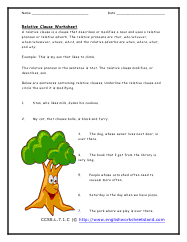Clause Worksheets To Print:
Subordinating and Coordinating - Join the sentences together and make them coherent.
Relative Clause - This is an identification activity.
Types of Relative - They are right the beach is pricey these days.
Linking Ideas - Beef up those sentences. This must be how writers of large screen plays feel.
What Is Missing? - That surely doesn't look like Tom?
Add a Clause Worksheet - Rewrite the sentences below by adding a relative clause that enhances each sentence.
To Comma or Not To Comma... - Your turn. Read each sentence and add commas where they are needed.
Subordinators - Read the sentences below and rewrite them to link the clauses together. You can reword the sentences but do not leave out any information.
Where and When - Can you write your own where and when clauses? Let's give it a try!
Adjective Clauses - Underline the part of the sentence that acts like this and circle the noun that it describes.
Adverb Clause - Fill in the blanks with an adverbial clause. Ask why, where, when, how or to what degree to help you. Write which question it answers on the line. The first has been done for you.
Adjectival Clauses - Fill in the blanks. Ask yourself which one or what kind to assist you. Write which question it answers on the line.
Linking In All Together - The following sentences need a clause(s) to link them into one sentence.
The Relative Clause In Sentences - Take your time to identify these within sentences. Make sure to get everything.
The Adjectival Clause - Fill in the blanks with an adverb or adjectival portion that is needed to enhance each sentence.
More Clause Worksheet Topics:
Cleft Sentences - A great way to drive the focus within a sentence and really press some hard emphasis down on things.
Independent and Dependent Clause - Learn how to identify them and reword them as needed.
Phrases and Clauses - Students examine the difference between the two and practice identifying and using them in sentences.
Place Phrases and Clauses - We focus on a singular faction of nouns and how to use them in your work.
Relative Clauses - They are used mostly to modify nouns and or pronouns.
Wish Clauses - When you are super hopeful that something just might go your way.
Get FREE English Worksheets In Your Email

